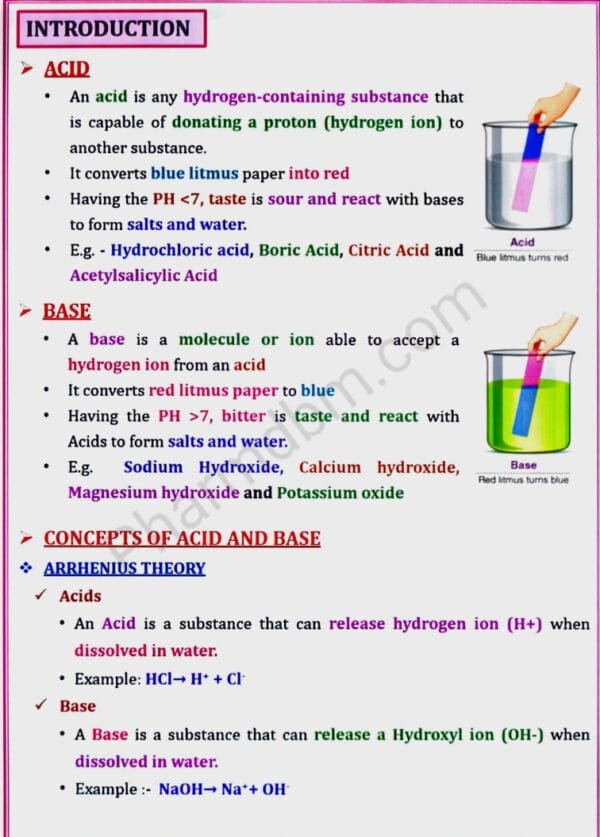
Free Download Pharmaceutical Inorganic Chemistry Notes in pdf – Bpharm 1st Semester. High-quality, well-structured and Standard Notes that are easy to remember.
Welcome to Pharmdbm.com
Pharmdbm provides standard or well-structured Notes for Bpharm students. The notes are free to download. Each semester notes of Bpharm are available on www.pharmdbm.com.
In this post you can download notes of Pharmaceutical Inorganic Chemistry (BP104T). All units are available to download for free.
Pharmaceutical Inorganic Chemistry Unit 1 – 5
UNIT – 1
Impurities in pharmaceutical substances, General methods of preparation

UNIT – 2
Acids, Bases & Buffer, Major extra and intracellular electrolytes, Dental products

UNIT – 3
Gastrointestinal agents – Acidifiers, Antacid, Cathartics, Antimicrobials

UNIT – 4
Miscellaneous compounds – Expectorants, Emetics, Haematinics, Poison and Antidote, Astringents

UNIT – 5
Radiopharmaceuticals

Syllabus of Pharmaceutical Organic Chemistry
UNIT – 1
Impurities in pharmaceutical substances: History of Pharmacopoeia,
Sources and types of impurities, principle involved in the limit test for
Chloride, Sulphate, Iron, Arsenic, Lead and Heavy metals, modified limit test
for Chloride and Sulphate
General methods of preparation, assay for the compounds superscripted
with asterisk (*), properties and medicinal uses of inorganic compounds
belonging to the following classes
UNIT – 2
Acids, Bases and Buffers: Buffer equations and buffer capacity in general,
buffers in pharmaceutical systems, preparation, stability, buffered isotonic
solutions, measurements of tonicity, calculations and methods of adjusting
isotonicity.
Major extra and intracellular electrolytes: Functions of major
physiological ions, Electrolytes used in the replacement therapy: Sodium
chloride, Potassium chloride, Calcium gluconate and Oral Rehydration Salt
(ORS), Physiological acid base balance.
Dental products: Dentifrices, role of fluoride in the treatment of dental
caries, Desensitizing agents, Calcium carbonate, Sodium fluoride, and Zinc
eugenol cement.
UNIT – 3
Gastrointestinal agents
Acidifiers: Ammonium chloride* and Dil. HCl
Antacid: Ideal properties of antacids, combinations of antacids, Sodium
Gastrointestinal agents
Acidifiers: Ammonium chloride* and Dil. HCl
Antacid: Ideal properties of antacids, combinations of antacids, Sodium
Gastrointestinal agents
Acidifiers: Ammonium chloride* and Dil. HCl
Antacid: Ideal properties of antacids, combinations of antacids, Sodium Bicarbonate*, Aluminum hydroxide gel, Magnesium hydroxide mixture
Cathartics: Magnesium sulphate, Sodium orthophosphate, Kaolin and
Bentonite
Antimicrobials: Mechanism, classification, Potassium permanganate, Boric
acid, Hydrogen peroxide, Chlorinated lime, Iodine and its preparations
UNIT – 4
Miscellaneous compounds
Expectorants: Potassium iodide, Ammonium chloride.
Emetics: Copper sulphate, Sodium potassium tartrate
Haematinics: Ferrous sulphate, Ferrous gluconate
Poison and Antidote: Sodium thiosulphate, Activated charcoal, Sodium
nitrite333
Astringents: Zinc Sulphate, Potash Alum
UNIT – 5
Radiopharmaceuticals: Radio activity, Measurement of radioactivity, Properties of α, β, γ radiations, Half life, radio isotopes and study of radio isotopes – Sodium iodide I131, Storage conditions, precautions & pharmaceutical application of radioactive substances.
Scope of Pharmaceutical Inorganic Chemistry
This subject deals with the monographs of inorganic drugs and pharmaceuticals.
Objectives of Pharmaceutical Inorganic Chemistry
Upon completion of course student shall be able to:
- Know the sources of impurities and methods to determine the impurities in inorganic
drugs and pharmaceuticals. - Understand the medicinal and pharmaceutical importance of inorganic compounds


